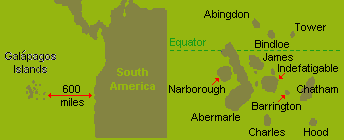HISTORY
The Galapagos archipelago has thirteen major islands, six minor islands with lots of smaller formations. The Islands are situated on the equator 600 miles off of the coast of Ecuador.
In 1485 The Incas from northern Peru were the first visitors. Then on 10 March 1535. Fray Tomas de Berianga, a Spanish bishop, made the official discovery. They first appeared on the world map in 1570 as the ‘Insulae de los Galopegos’.By the late 15th century pirates used the islands as a refuge and for water and meat, especially tortoise meat, they kept live tortoises on board. They also introduced dogs and goats onto the islands letting them breed for food at later visits.The first permanent human inhabitant was an Irishman called Patrick Watkins, who was marooned on Floreana in 1807. He was there for 8 years before escaping. The Ecuadorian government established prison colonies there and continued to use them until the mid 20th century. Coalmines and later mining for Guano began, but not for long, as there was not enough of either. Although, on Santiago salt, which was plentiful, from the salt lake near James Bay, was used for salting fish and tortoise meat. Several hundred whaling ships from Great Britain and the USA operated there for over a century.Evidence clearly indicates that the Galapagos never had native people, but the amount of settlers is increasing at an alarming rate.During World War II, the U.S. Navy obtained permission from the Ecuadorian government to establish bases in the Galapagos to protect the approaches to the Panama Canal. An airbase was established on Baltra, and a radar station on the north end of Isabela. The airbase was given to the Ecuadorian government shortly after the war and eventually transformed into the present commercial airport, operated by the Ecuadorian air force. Since then airports have been built on San Cristobal and Isabella.
The Galapagos Islands were once called the Enchanted Islands this was because they couldn’t be seen through the fog, so ships couldn’t find them.
During the four and a half centuries since their discovery, the Galapagos Islands have had a rich and varied history. Pirates, whalers, fur seal hunters, scientists, soldiers, convicts, fishermen, farmers, tourists and settlers have all left their mark on the islands, their plants and wildlife.
History The Galapagos archipelago has thirteen major islands, six minor islands with lots of smaller formations. The Islands are situated on the equator 600 miles off of the coast of Ecuador. In 1485 The Incas from northern Peru were the first visitors. Then on 10 March 1535. Fray Tomas de Berianga, a Spanish bishop, made the official discovery. They first appeared on the world map in 1570 as the ‘Insulae de los Galopegos’.By the late 15th century pirates used the islands as a refuge and for water and meat, especially tortoise meat, they kept live tortoises on board. They also introduced dogs and goats onto the islands letting them breed for food at later visits.The first permanent human inhabitant was an Irishman called Patrick Watkins, who was marooned on Floreana in 1807. He was there for 8 years before escaping. The Ecuadorian government established prison colonies there and continued to use them until the mid 20th century. Coalmines and later mining for Guano began, but not for long, as there was not enough of either. Although, on Santiago salt, which was plentiful, from the salt lake near James Bay, was used for salting fish and tortoise meat. Several hundred whaling ships from Great Britain and the USA operated there for over a century.Evidence clearly indicates that the Galapagos never had native people, but the amount of settlers is increasing at an alarming rate.During World War II, the U.S. Navy obtained permission from the Ecuadorian government to establish bases in the Galapagos to protect the approaches to the Panama Canal. An airbase was established on Baltra, and a radar station on the north end of Isabela. The airbase was given to the Ecuadorian government shortly after the war and eventually transformed into the present commercial airport, operated by the Ecuadorian air force. Since then airports have been built on San Cristobal and Isabella.
Three of the 14 races of tortoises have been lost forever and populations of others were considerably reduced (a single tortoise remains of the Pinta race). The native rice rat, one of the few indigenous Galapagos mammals is already extinct on many islands. Plants introduced on the settled islands are replacing the exceptional native species. Feral goats, pigs, burros, and cattle are destroying some islands. Introduced rats and feral cats, dogs, and pigs eat the eggs or young of the native birds and reptiles. Goats were eradicated from several islands. In 1965, the research station began a program of collecting tortoise eggs and bringing them to the research station where they would be hatched and raised to an age where they had a realistic chance of survival. They were then returned to their native islands. This occurred just in time to save the Espanola race of tortoises from extinction (only 11 females and 2 males remained). Falls in the populations of other races were reversed. Later, a similar program was begun for land iguanas. The Hawaiian Petrel was also close to extinction. Its breeding sites were protected and the population is increasing. The damage to whale populations has been enormous; fur seals were driven almost to extinction.
The Galapagos archipelago has thirteen major islands, six minor islands with lots of smaller formations. The Islands are situated on the equator 600 miles off of the coast of Ecuador.
 |
In 1485 The Incas from northern Peru were the first visitors. Then on 10 March 1535. Fray Tomas de Berianga, a Spanish bishop, made the official discovery. They first appeared on the world map in 1570 as the ‘Insulae de los Galopegos’.By the late 15th century pirates used the islands as a refuge and for water and meat, especially tortoise meat, they kept live tortoises on board. They also introduced dogs and goats onto the islands letting them breed for food at later visits.The first permanent human inhabitant was an Irishman called Patrick Watkins, who was marooned on Floreana in 1807. He was there for 8 years before escaping. The Ecuadorian government established prison colonies there and continued to use them until the mid 20th century. Coalmines and later mining for Guano began, but not for long, as there was not enough of either. Although, on Santiago salt, which was plentiful, from the salt lake near James Bay, was used for salting fish and tortoise meat. Several hundred whaling ships from Great Britain and the USA operated there for over a century.Evidence clearly indicates that the Galapagos never had native people, but the amount of settlers is increasing at an alarming rate.During World War II, the U.S. Navy obtained permission from the Ecuadorian government to establish bases in the Galapagos to protect the approaches to the Panama Canal. An airbase was established on Baltra, and a radar station on the north end of Isabela. The airbase was given to the Ecuadorian government shortly after the war and eventually transformed into the present commercial airport, operated by the Ecuadorian air force. Since then airports have been built on San Cristobal and Isabella.
The Galapagos Islands were once called the Enchanted Islands this was because they couldn’t be seen through the fog, so ships couldn’t find them.
During the four and a half centuries since their discovery, the Galapagos Islands have had a rich and varied history. Pirates, whalers, fur seal hunters, scientists, soldiers, convicts, fishermen, farmers, tourists and settlers have all left their mark on the islands, their plants and wildlife.
History The Galapagos archipelago has thirteen major islands, six minor islands with lots of smaller formations. The Islands are situated on the equator 600 miles off of the coast of Ecuador. In 1485 The Incas from northern Peru were the first visitors. Then on 10 March 1535. Fray Tomas de Berianga, a Spanish bishop, made the official discovery. They first appeared on the world map in 1570 as the ‘Insulae de los Galopegos’.By the late 15th century pirates used the islands as a refuge and for water and meat, especially tortoise meat, they kept live tortoises on board. They also introduced dogs and goats onto the islands letting them breed for food at later visits.The first permanent human inhabitant was an Irishman called Patrick Watkins, who was marooned on Floreana in 1807. He was there for 8 years before escaping. The Ecuadorian government established prison colonies there and continued to use them until the mid 20th century. Coalmines and later mining for Guano began, but not for long, as there was not enough of either. Although, on Santiago salt, which was plentiful, from the salt lake near James Bay, was used for salting fish and tortoise meat. Several hundred whaling ships from Great Britain and the USA operated there for over a century.Evidence clearly indicates that the Galapagos never had native people, but the amount of settlers is increasing at an alarming rate.During World War II, the U.S. Navy obtained permission from the Ecuadorian government to establish bases in the Galapagos to protect the approaches to the Panama Canal. An airbase was established on Baltra, and a radar station on the north end of Isabela. The airbase was given to the Ecuadorian government shortly after the war and eventually transformed into the present commercial airport, operated by the Ecuadorian air force. Since then airports have been built on San Cristobal and Isabella.
Three of the 14 races of tortoises have been lost forever and populations of others were considerably reduced (a single tortoise remains of the Pinta race). The native rice rat, one of the few indigenous Galapagos mammals is already extinct on many islands. Plants introduced on the settled islands are replacing the exceptional native species. Feral goats, pigs, burros, and cattle are destroying some islands. Introduced rats and feral cats, dogs, and pigs eat the eggs or young of the native birds and reptiles. Goats were eradicated from several islands. In 1965, the research station began a program of collecting tortoise eggs and bringing them to the research station where they would be hatched and raised to an age where they had a realistic chance of survival. They were then returned to their native islands. This occurred just in time to save the Espanola race of tortoises from extinction (only 11 females and 2 males remained). Falls in the populations of other races were reversed. Later, a similar program was begun for land iguanas. The Hawaiian Petrel was also close to extinction. Its breeding sites were protected and the population is increasing. The damage to whale populations has been enormous; fur seals were driven almost to extinction.
In the year 1935, the one hundredth anniversary of Darwin's visit,
the Ecuadorian government decreed 95% of the islands as wildlife
preserves. Later, the ocean surrounding the islands were declared
a Marine Reserve and placed under the park's jurisdiction as well.
Tourism has grown enormously to where 60,000 people visited annually
in the 1990's. |
 |
The
impact of this on the islands is not as bad as it could have been
due to the continuous efforts of the Galapagos National park Service,
the Charles Darwin Research Station and tour operators. Tourists
eat and sleep on tour boats and are allowed to come ashore only
in designated areas, and then only under the supervision of licensed
guides. So there is hope for these remarkable islands, after a
rocky start we are a last learning from our mistakes. |
|